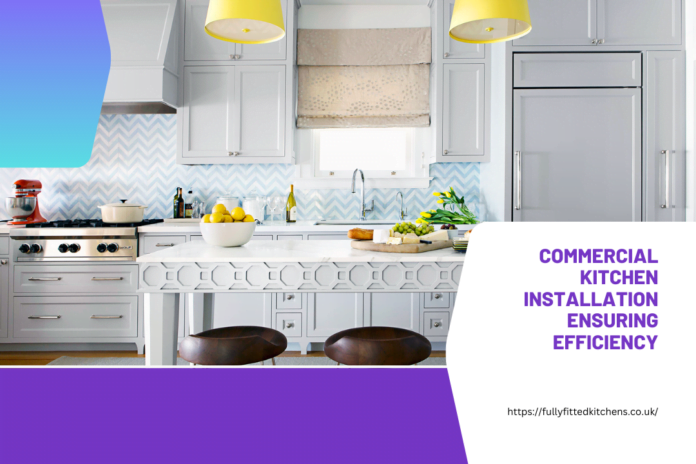Introduction
A commercial kitchen is the heart of any food-related business, be it a restaurant, hotel, or catering service. The success of such establishments heavily relies on the efficiency and safety of their culinary spaces. One crucial aspect that ensures these elements are met is the proper installation of the commercial kitchen. In this article, we will delve into the intricacies of commercial kitchen installation, its importance, the planning process, avoiding common mistakes, and the benefits of professional installations.
Understanding Commercial Kitchen Installations
Importance of Proper Installation
The significance of a well-planned and expertly executed commercial kitchen installation cannot be understated. A properly installed kitchen layout optimizes workflow, reduces the risk of accidents, and enhances overall productivity. Additionally, a well-designed kitchen makes the best use of available space, ensuring maximum efficiency and ease of movement for the kitchen staff.
Factors to Consider Before Installation
Before embarking on a commercial kitchen installation project, several crucial factors need consideration. Among these are the type of cuisine to be prepared, the volume of food expected to be produced, and the number of kitchen staff. Assessing these variables allows for the selection of the most suitable kitchen equipment and layout.
Types of Commercial Kitchen Installations
Commercial kitchens can vary significantly based on the type of food service establishment. These establishments include restaurants, hotels, cafes, bakeries, and catering companies. Each type has unique kitchen requirements that demand tailored installation solutions.
Planning Your Commercial Kitchen Installation
Assessing Space and Layout
One of the initial steps in commercial kitchen installation planning is assessing the available space and creating a functional layout. The layout should prioritize the logical flow of food preparation, minimizing unnecessary movement and time wastage.
Selecting the Right Equipment
Choosing the appropriate kitchen equipment is crucial to meet the specific needs of the establishment. The selection process should consider factors such as energy efficiency, durability, and compliance with safety standards.
Compliance with Safety Regulations
Safety should be the top priority when installing a commercial kitchen. Ensuring compliance with relevant safety regulations and obtaining necessary permits is essential to prevent accidents and potential legal issues.
Finding the Right Professionals for the Job
Hiring Experienced Contractors
The success of a commercial kitchen installation heavily depends on the skills and expertise of the contractors involved. It is imperative to hire experienced professionals who have a track record of successful installations.
Getting Multiple Quotes
Obtaining multiple quotes from different contractors allows for better cost comparison and ensures that you get the best value for your investment.
Checking References and Portfolios
Before finalizing any contractor, check their references and review their previous projects. This step will provide insight into the quality of their work and the satisfaction of their previous clients.
The Installation Process
Site Preparation
Before starting the installation, the site must be prepared adequately. This includes clearing the area, checking utilities, and ensuring proper ventilation and exhaust systems are in place.
Electrical and Plumbing Setup
The installation of commercial kitchen equipment requires careful attention to electrical and plumbing connections to ensure seamless functionality.
Installing Kitchen Equipment
The actual installation of the kitchen equipment should be done with precision and adherence to safety guidelines.
Testing and Quality Assurance
After installation, thorough testing and quality assurance checks are essential to identify any issues and ensure the kitchen operates optimally.
Avoiding Common Installation Mistakes
Poor Space Utilization
Failing to make the best use of available space can lead to cramped and inefficient kitchen operations.
Ignoring Ventilation and Exhaust Systems
Inadequate ventilation and exhaust systems can result in poor air quality and compromise the health and safety of kitchen staff.
Overlooking Safety Measures
Cutting corners on safety measures can lead to accidents and costly liabilities.
Maintaining Your Commercial Kitchen
Regular Cleaning and Inspections
Regular cleaning and inspections are necessary to maintain a hygienic and safe kitchen environment.
Scheduled Equipment Maintenance
Scheduled maintenance of kitchen equipment ensures optimal performance and prolongs its lifespan.
Upgrading and Renovating
As the business grows, periodic upgrades and renovations may be necessary to accommodate changing needs and technology advancements.
The Cost of Commercial Kitchen Installations
Factors Affecting Installation Costs
The cost of a commercial kitchen installation can vary based on factors such as the size of the space, equipment selection, and the complexity of the installation.
Budgeting and Financing Options
Proper budgeting and exploring financing options can help manage the costs of the installation.
Advantages of Professional Installations
Improved Efficiency and Workflow
Professional installations ensure that the kitchen layout maximizes efficiency, leading to smoother operations and increased productivity.
Enhanced Safety and Compliance
Expertly installed kitchens adhere to safety regulations, reducing the risk of accidents and potential legal liabilities.
Long-Term Cost Savings
Well-planned installations and high-quality equipment result in reduced maintenance costs and energy efficiency, leading to long-term cost savings.
Conclusion
A well-designed and expertly installed commercial kitchen is vital for the success of any food-related business. By understanding the importance of proper installation, planning diligently, hiring experienced professionals, and adhering to safety regulations, you can create a culinary space that ensures efficiency, safety, and profitability.
FAQs
How long does a typical commercial kitchen installation take?
The duration of a commercial kitchen installation varies depending on the size and complexity of the project but can range from a few weeks to several months.
Is it necessary to hire a professional contractor for the installation?
Yes, hiring a professional contractor is highly recommended to ensure a successful and compliant installation.
Can I make changes to the kitchen layout after installation?
Yes, it is possible to make changes to the kitchen layout post-installation, but it may involve additional costs and downtime.
What are some common safety regulations for commercial kitchens?
Common safety regulations include proper ventilation, fire safety measures, and food handling protocols.
How often should I schedule maintenance for my kitchen equipment?
Regular maintenance is crucial, and scheduling it quarterly or semi-annually is advisable to keep the equipment in top condition.

